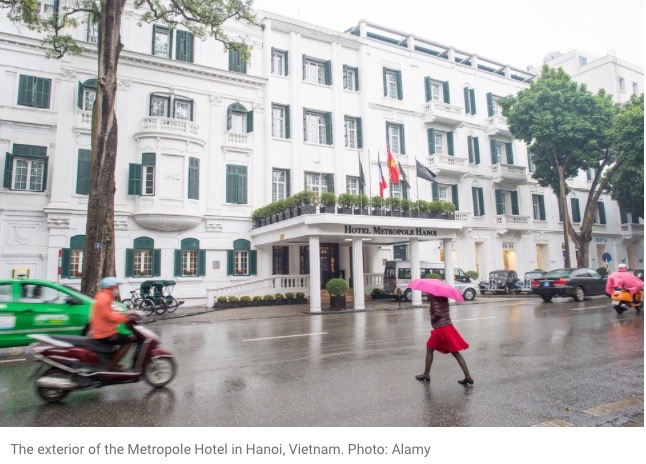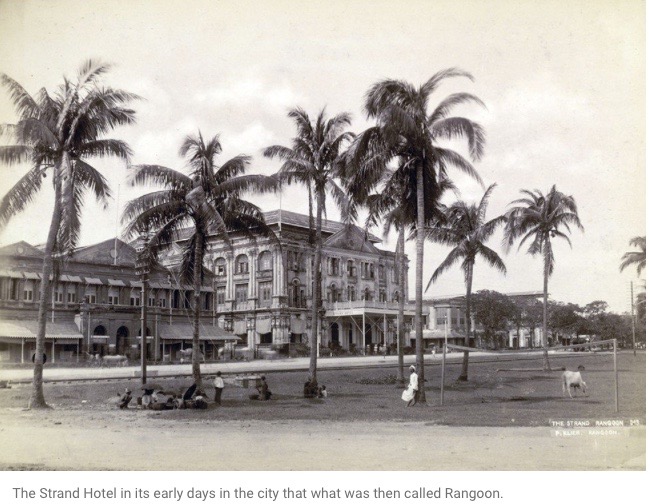Writers once travelled through Asia in a leisurely fashion, steamers gently rolling between Bangkok and Batavia, rickshaws wheeling through the streets of Singapore, pleasure boats pulling into Penang. European wanderers, adventurers and authors drank gin slings while waiting for sumptuous dinners; colonial matrons sipped tea on hotel balconies; and the business of empire rumbled on.
Colonial Asia (or the Far East, as it was then known) was replete with hotels for the well off, and well-travelled novelists in search of rich material. Rudyard Kipling, Somerset Maugham, Joseph Conrad all added spice to their writing while spending time in Asia.
Today a number of these grand establishments are still standing.
The Raffles in Singapore, the Oriental (now known as the Mandarin Oriental) in Bangkok, the Metropole in Hanoi, the Strand in Rangoon (Yangon) and the Eastern and Oriental in Penang all hosted writers of varying calibre.
1. The Raffles, Singapore
The Raffles in Singapore has recently taken steps to entrench this heritage in the decades to come by offering both established and unknown authors of today up to four weeks’ free accommodation (if their applications are approved). Two authors will be chosen each year for its new Writer’s Residency Programme, and the first, British writer Pico Iyer, who has written a book about the hotel, has already won one of the places.
With its gleaming white frontage and tall arched windows, the imposing Raffles is perhaps the queen of Asian grande dame hotels. In an eternally bustling and crowded city state where much of the colonial architecture dating back to the days of British Malaya has given way to modern skyscrapers, the Raffles echoes a bygone era.
William Somerset Maugham, the British novelist who wrote The Moon and Sixpence and Of Human Bondage, made a habit of staying in the great hotels of the region
He once said, “Raffles stands for all the fables of the exotic East” – a phrase that has since been quoted again and again.
Another British author, Rudyard Kipling of Kim and The Jungle Book fame, was less of a marketer’s dream. He enjoyed his meals at The Raffles but complained about a hotel “where the food is as excellent as the rooms are bad”.
Still, with a comprehensive renovation completed in August this year, the Raffles now offers all mod cons, from comprehensively appointed rooms and fine dining to a limousine service and a spa.
2. Metropole, Hanoi, Vietnam
The Hotel Metropole opened in 1901, in Hanoi, in that part of the world then known as Tonkin, in French Indochina. From the very beginning the Metropole was a landmark in the tumultuous history of Vietnam.
In the early 1900s Vietnamese freedom fighters took to kidnapping and bomb-throwing. By 1945 this violent uprising had grown into the ultimately successful rebellion led by Ho Chi Minh against French rule, a struggle that was in turn followed by the Vietnam war.
 Somerset Maugham wrote some of his travelogue The Gentleman in the Parlour at the Metropole, and now the hotel has a Somerset Maugham suite.
Somerset Maugham wrote some of his travelogue The Gentleman in the Parlour at the Metropole, and now the hotel has a Somerset Maugham suite.
Graham Greene wrote part or all of his 1955 novel The Quiet American in the hotel, and now, naturally, there is a sumptuous Graham Greene suite.
In 1930, the remarkably unflustered Noel Coward stayed for a while. The famed English playwright, actor and director had motored up from Haiphong harbour for a visit, majestically ignoring the rumbles of war.
“Outside the revolution was in full swing, and there was occasionally the sound of gunfire,” he wrote. “Inside all was peaceful and well-ordered. The dinner was delicious, the wine excellent, and Monsieur Pasquier the most delightful host.”
3. Mandarin Oriental, Bangkok, Thailand
On the banks of the mighty Chao Phraya river in central Bangkok, the Oriental once welcomed guests arriving by boat from the steamships that rolled almost every day in the early 1900s, often via Singapore, Hong Kong or Saigon.
A grand opening day in 1887, with a banquet and two orchestras, celebrated the launch of the Oriental’s new incarnation – an architect-designed edifice.
This building, which supplanted an earlier Oriental, is still standing, and known today as the Authors’ Wing – there’s an Authors’ Suite too: the Mandarin Oriental has made much of its literary associations.
A more modern wing is currently having an elderly lady’s nip and tuck, due to be finished in mid-November.
The indefatigable Somerset Maugham stayed at the Oriental in 1920s. He wrote a children’s story, a Siamese Fairy Tale, while he was staying there and endured a savage bout of malaria.
Coward also stayed at the hotel, declaring: “It is a lovely place, and I am fonder of it than ever.”
4. Eastern and Oriental, Penang, Malaysia
Cooled by sea breezes, the E&O was a European-style oasis in British Malaya’s tin-mining and rubber-planting Straits Settlements.
These days, the modern E&O remains notable for its long sweep of seafront, its vast lobby and its rooms looking out to the Malacca Strait. Modern additions include a sparkling pool near the sea wall so guests can loll on deckchairs and leap into the pool for a cooling dip whenever they choose.
A lengthy facelift of the hotel’s Heritage Wing is under way, and expected to be completed by December this year.
The German novelist, poet and Nobel laureate Hermann Hesse, who wrote Steppenwolf and Siddharta, visited the E&O in 1911, finding “the most beautiful hotel in the East Indies that I came across for Europeans”.
5. The Strand, Yangon, Myanmar
A boom town in the early 1900s, Rangoon (now known as Yangon) boasted emporia selling crockery, millinery, drapery, haberdashery and anything else the colonial matron might need.
Writer John Murray, in his 1911 Handbook for Travellers in India, Burma and Ceylon, declared The Strand as “the finest hostelry East of Suez”. Kipling had a couple of decades earlier made Burma a household name, with his 1890 barrack-room ballad Mandalay.
The hotel’s colonnaded facade faces the Yangon River and, unlike many other grande dame hotels, The Strand has had minimal modern overlay. It has been comprehensively renovated, but no pool or modern wing has been attached to the historic structure.
Inside, the ambience is recognisably tropical-Victorian: cane furniture, marble floors, chandeliers, black lacquered ceiling fans, potted palms, and soaring ceilings.
One of British India’s biggest and most trading hubs, the city was home to merchants and entrepreneurs, tiny shops and enormous corporations: Burmah Oil, an ancestor of BP, was just one of the companies making money hand over fist in colonial Burma, now known as Myanmar.
Today the hotel remains an important monument in the history of modern Yangon, where decades of economic neglect has had the unexpected benefit of preserving a rich array of colonial buildings.
Writer John Murray, in his 1911 Handbook for Travellers in India, Burma and Ceylon, declared The Strand as “the finest hostelry East of Suez”. Kipling had a couple of decades earlier made Burma a household name, with his 1890 barrack-room ballad Mandalay.
The hotel’s colonnaded facade faces the Yangon River and, unlike many other grande dame hotels, The Strand has had minimal modern overlay. It has been comprehensively renovated, but no pool or modern wing has been attached to the historic structure.
Inside, the ambience is recognisably tropical-Victorian: cane furniture, marble floors, chandeliers, black lacquered ceiling fans, potted palms, and soaring ceilings.
https://www.scmp.com/lifestyle/travel-leisure/article/3031820/five-historic-asian-hotels-hosted-famous-writers-conrad
